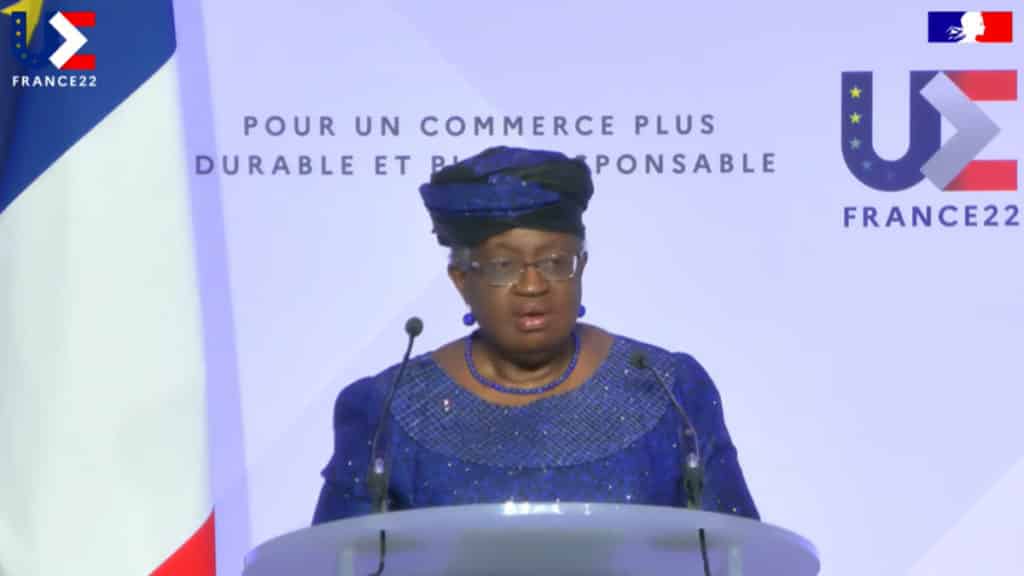La DG Okonjo-Iweala declara en una conferencia sobre sostenibilidad que “el comercio es parte de la solución a los desafíos que afrontamos”

La Directora General Ngozi Okonjo-Iweala afirmó que el comercio y la política comercial pueden contribuir a alcanzar las metas mundiales de sostenibilidad, de forma más efectiva y eficiente, en el marco de su discurso de apertura de la Conferencia “Hacia un Comercio más Sostenible y Responsable”, organizada el 28 de enero por el Ministro de Comercio francés, Franck Riester, para celebrar la Presidencia de Francia del Consejo de la Unión Europea en 2022. Tras explicar las formas en que el comercio contribuye, y podría contribuir aún más, a la acción climática, la conservación de la biodiversidad y la inclusión socioeconómica, instó a los Gobiernos a mejorar su utilización del comercio y de la OMC como instrumentos para la sostenibilidad ambiental.
(de momento sólo en inglés)
DG Okonjo-Iweala noted sustainable development was a goal written into the WTO’s founding agreements in 1994, and that «exciting initiatives are underway at the WTO» to respond to sustainability challenges such as plastics pollution and climate change. Her full speech is below.
Minister Franck Riester, first of all, congratulations on this conference. I’m really delighted to be here with you today – and even more delighted that France has decided to kick off its EU presidency by looking at the important question of how trade policy can better help us achieve global sustainability goals. Thank you to Minister Riester and his team for their work to bring all of us together.
Even as we continue to grapple with the COVID-19 pandemic, some of the biggest threats to our economies and our societies come from environmental degradation – from climate change to biodiversity loss.
- The World Bank estimates that natural disasters already cost low- and middle-income countries $390 billion per year in damage related to water, transport, and power infrastructure.
- The pandemic’s economic impact was immense, and immediate, demanding $26 trillion in fiscal and monetary support, on the order of 30% of global economic output in 2020.
- If we fail to adequately address climate change, the costs will accumulate over several years, but they will be even bigger.
The risks we confront are interlinked. As we encroach upon the natural habitats of different animal species, it increases the chances that new zoonotic diseases will jump from animal hosts to humans. Illegal wildlife trade similarly increases the potential for future pandemics.
This has been called an age of ‘polycrisis’ – of intersecting crises in the economy, the environment, and in public health.
These crises demand multi-faceted responses.
- We need to reduce poverty while increasing environmental sustainability.
- We must drive the health and economic recovery from COVID-19 by building greener, more socially inclusive economies, and investing in the systems needed to identify and contain future disease outbreaks.
If you take one thing away from what I say here today, please make it this: trade is part of the solution to the challenges we face, far more than it is part of the problem.
Across every dimension of sustainability – economic development, social inclusion, and environmental conservation – leveraging the full power of trade and trade policy will help us achieve our goals more effectively and efficiently.
Over the next twenty minutes or so, I will point to examples of how trade already contributes to each dimension of sustainable development – and how it can do much more, though there is no replacement for complementary domestic policies for socioeconomic equity and environmental protection.
I will focus on environmental sustainability, since trade has an underappreciated role to play in enabling a just low-carbon transition, enhancing marine biodiversity, and addressing plastics pollution and deforestation. And I will tell you about some exciting initiatives underway at the WTO that promise to make better use of trade as an instrument for environmental sustainability.
But first I want to speak briefly to the widespread belief that trade is part of the problem when it comes to the environment. There are, inevitably, some challenges associated with trade:
- Moving goods from one place to the other has generally involved carbon emissions.
- Shipping accounted for almost 3% of anthropogenic carbon emissions in 2018, according to the International Maritime Organization, though this also included domestic shipping and fishing activity. Increased shipping volumes more than offset efficiency gains in terms of carbon intensity.
- The aviation industry, which includes passenger transport as well as air freight, accounts for just over 2% of emissions.
- Global trade has been one factor in making plastics – and plastics pollution – ubiquitous around the world, including in our oceans.
Another source of negative perceptions around trade comes from socioeconomic exclusion. Trade and open global markets have helped lift over a billion people out of poverty in recent decades, most dramatically in China. In 1980, close to 40% of the world population lived on less than the equivalent of $1.90 a day. By 2019, it was less than 10%, but of course the pandemic has set us back in terms of poverty numbers. Nevertheless it was possible for us to imagine the end of extreme poverty as envisioned in the Sustainable Development Goals. But suffice it to say that many poor people in rich countries, as well as poor countries, have not shared fully in the gains.
But the answer to these problems does not lie in a rejection or reduction of trade. That would not help the 100 million people pushed into extreme poverty by the pandemic. It would not help developing economies make up the ground lost in the K-shaped economic recovery that has characterised the past year and a half. It would not help women and small businesses tap into international market opportunities. Trade makes production more efficient, which can reduce emissions. It is also a key mechanism for the diffusion around the world of new, less polluting technologies. A new joint policy note from the WTO and the World Bank makes clear that trade will be critical in driving the post-pandemic recovery.
A better answer to the real problems we see lies in better trade – in a better globalisation, or, as I term it, a re-globalization – one that brings marginalized people and countries into the economic mainstream, while helping us decouple human well-being from environmental impact. That is what this conference is about; sustainability.
Now let’s look at some different ways trade can contribute to curbing climate change, while ensuring a just transition for the countries that did the least to contribute to the problem.
Climate change is already affecting trade, from changing rainfall patterns to extreme weather events. Trade can be a powerful tool to support climate change adaptation and mitigation, particularly for developing countries.
Trade is a mechanism for adaptation and resilience in the face of crop failure and natural disasters. Affected countries can bring in food and supplies necessary for reconstruction while domestic production remains impaired, allowing the economy to recover more quickly. One set of models published in the magazine Nature Climate Change a year and a half ago estimated that climate change was on track to push 55 million people into undernourishment by 2050 because of localised impacts on food production. It found that greater trade integration through tariff cuts and trade facilitation could cut that number by as much as 64%, or 35 million people. Meanwhile, reducing trade in agricultural products would substantially increase the number of people likely to go hungry in the decades ahead.
On the mitigation side, international competition and the emergence of a globally integrated solar photovoltaic (PV) supply chain has helped make solar the cheapest source of electricity generation in many parts of the world. Lower costs, helped by innovation as well as the ability to source inputs and services from wherever they are most competitive, have driven a 100-fold increase in cumulative solar PV installed capacity between 2005 and 2018. Wind energy has benefited from similar trends. While it is important to ensure these value chains themselves are environmentally and socially sustainable, trade and competition can play similar roles in lowering costs for future technologies such as advanced batteries and hydrogen electrolysers.
Lowering trade barriers to environmental goods and services would further reduce the cost of renewable energy, and lower the capital costs of building climate-resilient infrastructure. The scope for liberalisation is significant. Tariffs on renewable energy goods and heat pumps are often between 10 and 14%. Non-tariff barriers on clean goods are frequently more demanding than for dirty goods. In 2016, a group of WTO members developed a plan to liberalize trade in around 250 to 300 environmental goods, including products to control air pollution and increase energy efficiency, but shelved it because of concerns that the benefits would be skewed disproportionately towards some countries. Politics trumped the environment back then, but it’s worth another try now. WTO members could start with a small list of products and services, and build out from there. Let’s hope we can revive the 2016 negotiations.
The International Energy Agency estimates that meeting Paris Agreement targets would require annual clean energy investments to triple to $4 trillion by 2030. An open, competitive, predictable trading environment would help ensure these expenditures get the most bang for the buck. This is important for maximising emissions reductions and providing value for money to taxpayers. It is why governments rolling out incentives for green investment at home should work with each other to ensure that international competition remains vigorous as well as fair.
Green investment on the scale we need could lead to supply bottlenecks and upward price pressures that have been dubbed ‘greenflation’. The WTO’s successful work with vaccine manufacturers could provide a template for possible future work with the private sector to ensure that green goods and services, and key inputs, flow smoothly across borders as needed.
Countries around the world currently subsidise fossil fuel production and consumption to the tune of $500 billion. Reforming these subsidies would reduce emissions while freeing public funds to be put to better use.
And finally, international cooperation can help ensure that efforts to put a price on carbon do not lead to avoidable business costs and trade frictions, or place disproportionate burdens on poor countries. Nearly 70 different carbon pricing schemes are now in force globally, with different sectoral coverage and wildly varying prices – from less than $1 per ton of CO2 in Poland and Ukraine to more than $130 in Sweden. Canada is planning to increase its carbon price from C$50 per tonne this year to C$170, currently worth US$135, in 2030. This fragmentation raises compliance costs and uncertainty for the private sector – and weighs heaviest on small businesses. In addition, some developed countries are, as we all know, considering «border tax adjustment measures», such as the European Union, which is intended to equalize carbon costs across foreign and domestic producers.
While this sounds reasonable enough in principle, many developing countries fear that such measures could in practice be misused as a pretext for protectionism against their exports. I’m happy to hear from M how there is careful work to ensure the CBAM would be WTO-compatible. We must work hard with developing countries to ensure they do not see this as protectionist and that we can thereby increase global cooperation on climate change.
I am convinced the WTO needs to be proactive about these issues, otherwise we will be on the receiving end of inevitable trade tensions. The IMF is doing work on a phased approach to a global carbon price, and the WTO and OECD are also doing joint analysis of carbon pricing. All three organizations have agreed to collaborate on this work, and I think the international community should be focused on getting international organizations to come up with a methodology that takes into account the views and economics of developing countries.
Climate-related trade policies must be framed with a just transition in mind, with transition times for developing countries to find carbon alternatives, but also the financing for them to leapfrog the dirty infrastructure stage and directly build sustainable alternatives. In fact, this should be viewed as an investment opportunity. Two-thirds of Africa’s infrastructure is yet to be built, and there is every opportunity to build this infrastructure greener and better and trade can be instrumental in making this happen.
There’s an important link here with aid for trade: trade-related development assistance built energy, transport, and telecommunications infrastructure totalling $25 billion in 2019. Going forward, aid for trade should seek to build climate-resilient infrastructure and foster climate-proof supply chains.
There’s also scope to work with the private sector and relevant international organizations to reduce emissions associated with maritime, air and road transport. Shipping group AP Moller-Maersk is seeking to cut emissions per container by half by 2030, and increasing the share of freight it transports using lower-carbon fuels like green methanol. MSC, another shipping company, has targeted complete net decarbonization by 2050, and seeks to have its first net zero carbon emissions capable ship in service by 2030. According to Lloyd’s Register, the decade ahead will be critical for piloting and prototyping the new green fuels and hybrid propulsion arrangements needed for the sector to get to net zero by 2050.
Turning now to some other environmental challenges where trade policy can play a useful role.
One is marine biodiversity and ocean health. You may be aware that WTO members are negotiating an agreement to cut tens of billions of dollars in annual subsidies that encourage too many ships to chase too few fish. This public spending has contributed to a situation where nearly half of global marine fish stocks are overfished, according to the new study by the Minderoo foundation, threatening the livelihoods of 260 million people. WTO members after 20 years of effort are now within striking distance of a deal – and I hope they will get there soon.
Another challenge is plastics pollution, which is a growing threat to land and ocean resources as well as human health. Trade policy cooperation could improve transparency, align standards and regulations to favour recyclability and compostability and create markets for plastics substitutes. Countries could lower trade barriers to environmental goods and services required to make plastics supply chains more circular – that is, to use plastic waste as feedstock for making plastic – and to promote sustainable alternatives where appropriate.
In principle, trade in plastic waste is covered by the Basel Convention on transboundary movements of hazardous waste and their disposal. But the reality is that there is considerable illegal trade that circumvents the convention’s requirements for importing countries to provide prior informed consent before shipments of plastic waste depart. We need to work on the problem throughout the plastics lifecycle. The United Nations Environment Assembly next month may launch negotiations for a new plastics treaty. WTO work on plastics is complementing these efforts on the trade-related aspects, including via the new structured discussions among members that I will come back to.
There is also scope for improved action at the national level. Some of the biggest exporters of plastic waste are developed countries. Why allow the export of waste you don’t want in your domestic market? Why not encourage innovation in more biodegradable packaging materials? We hear of several scientific innovations in this space, and hope such innovations can soon be brought to market and scaled up. There’s a business case here too – consumers, especially younger generations, want more sustainable products.
Deforestation is yet another area where trade can help serve environmental goals. Forest loss is bad for biodiversity conservation, carbon sequestration, and the maintenance of ecosystems.
At COP26, the Glasgow Leaders’ Declaration on Forests and Land Use, signed by leaders representing over 85% of the world’s forests, committed to halt and reverse deforestation and land degradation by 2030. 28 governments and the EU supported a Forest, Agriculture and Commodity Trade (FACT) Statement, which brought together producer and consumer countries to identify ways to reduce deforestation in supply chains, encourage more sustainable production, improve livelihoods, and build new markets for sustainably grown products.
Now let me address more explicitly what the WTO is doing on these issues. If trade is part of the solution to the challenges we have been discussing, the good news is that WTO members are engaging in Geneva to find ways forward.
Sustainable development has been part of the WTO since day one. Using trade to promote sustainable development is literally written into the preamble of the WTO’s founding agreements from 1994. Alongside job creation and enhanced living standards, sustainability is seen as a key means by which trade and the WTO can help improve people’s lives.
WTO members have used our Committee on Trade and Environment to debate these issues. As part of standard transparency requirements, governments are required to formally notify new trade policies to the WTO. Since 2009, over 4500 of the measures notified have had objectives related to climate mitigation and adaptation. Many of these are technical regulations for energy efficiency and other goals, but they also include direct taxes on carbon, green procurement requirements, and support programmes for renewable energy. Members have used the Committee on Trade and Environment to learn from each other’s experiences, discuss each other’s measures, and address potential trade irritants arising from them. They have also notified over 500 measures for sustainable forestry management, and over 1400 for sustainable agriculture. The key takeaway here is that the WTO offers a mechanism for minimizing trade frictions and for identifying win-win opportunities. Only a tiny fraction of environmental policies have led to formal trade disputes.
As useful as these existing processes are, the sustainability challenges we face today go beyond what the WTO’s architects could have imagined back in 1994.
And that’s why I’m excited about three new environmental initiatives that large groups of members have been taking forward at the WTO. More than 80 members representing over 85% of global trade, including the EU, China, and the US, are part of at least one of these three initiatives. Over half of them are developing countries. Alongside the fisheries subsidies negotiations, these initiatives are a sign that countries see trade, trade policy, and the WTO as central components of their environmental sustainability efforts. They complement inclusion-oriented initiatives seeking to better equip women and micro, small, and medium-sized enterprises to benefit from global trade.
Let me briefly say a word on each of the three new initiatives.
- The Structured Discussions on Trade and Environmental Sustainability, bring 71 members together to look at issues including climate change, environmental goods and services, circular economy, sustainable supply chains, greening aid for trade, and the environmental impacts of farm subsidies. Participants have defined a road map for work in 2022, and set up exchanges with business, civil society, and academic experts with an eye to solutions for emerging challenges.
- The Informal Dialogue on Plastics Pollution and Environmentally Sustainable Plastics Trade (IDP) seeks to foster coordinated action to address the environmental, health and economic costs of plastics pollution. Its 68 co-sponsors will discuss transparency, trade trends, and best practices, while exploring the scope for collective approaches and how best to complement other international processes and meet the technical assistance needs of developing countries.
- And finally, 45 members will be working on Fossil Fuel Subsidy Reform, examining options to rationalize and phase out subsidies that encourage wasteful consumption – and how to minimize negative social impacts on poor people and developing countries.
Processes matter – but decisions matter even more. In all of these initiatives, I have been encouraging members to get to some relatively easy deliverables – for instance, on transparency in plastics trade. This will build momentum for delivering more results in the future.
Let me just say a word on one of the issues we are grappling with now around COVID-19 vaccines, therapeutics, and diagnostics and trying to get a solution on intellectual property access. The solutions we find may prove relevant to decarbonization efforts, which also demand the innovation and development of new technologies in tandem with rapid worldwide diffusion.
I see the work we are doing now is very relevant to issues on climate change and the environment. In concluding, let me reiterate that trade can and must help us respond to the problems we face in our economies, societies, and the natural environment. Judicious trade policy choices can help us prepare from future risks and shocks. I always say the future of trade is services and digital, but I emphasize that the future of trade must also be green. So let’s keep working to put trade in the service of sustainable development. Thank you.











